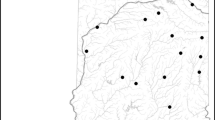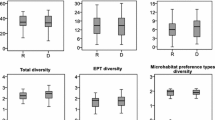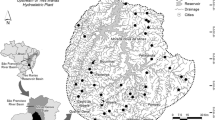Abstract
Macroinvertebrate assemblages were related to environmental factors that were quantified at the sample scale in streams subjected to a gradient of cattle grazing. Environmental factors and macroinvertebrates were concurrently collected so assemblage structure could be directly related to environmental factors and the relative importance of stressors associated with cattle grazing in structuring assemblages could be assessed. Based on multivariate and inferential statistics, measures of physical habitat (% fines and substrate homogeneity) had the strongest relationships with macroinvertebrate assemblage structure. Detrital food variables (coarse benthic and fine benthic organic matter) were also associated with assemblage structure, but the relationships were never as strong as those with physical habitat measures, while autochthonous food variables (chlorophyll a and epilithic biomass) appeared to have no association with assemblage structure. The amount of variation explained in taxa composition and macroinvertebrate metrics is within values reported from studies that have examined macroinvertebrate metric–sediment relationships. The % Coleoptera and % crawlers had consistent relationships with % fines during this study, which suggests they may be useful metrics when sediment is a suspected stressor to macroinvertebrate assemblages in Blue Ridge streams. Findings from this study also demonstrate the importance of quantitative sampling through time when research goals are to identify relationships between macroinvertebrates and environmental factors.
Similar content being viewed by others
References
Angradi T. R. (1999). Fine sediment and macroinvertebrate assemblages in Appalachian streams: a field experiment with biomonitoring applications. Journal of the North American Benthological Society 18(1): 49–66
Barbour M. T., Gerritsen J., Snyder B. D. and Stribling J. B. (1999). Rapid Bioassessment Protocols for Use in Streams and Wadeable Rivers: Periphyton, Benthic Macroinvertebrates, and Fish. Office of Water, U.S. Environmental Protection Agency, Washington DC
Bouckaert F. W. and Davis J. (1998). Microflow regimes and the distribution of macroinvertebrates around stream boulders. Freshwater Biology 40(1): 77–86
Brigham A. R., Brigham W. U. and Gnilka A. (1982). Aquatic Insects and Oligochaetes of North and South Carolina. Midwest Aquatic Enterprises, Mahomet, IL
Brown H. P. (1987). Biology of riffle beetles. Annual Review of Ecology and Systematics 32: 253–273
Burton J. and Gerritsen J. (2003). A Stream Condition Index for Virginia Non-coastal Streams. Tetra Tech Inc, Owings Mill, MD
Carter J. L. and Resh V. H. (2001). After site selection and before data analysis: sampling, sorting and laboratory procedures used in stream benthic macroinvertebrate monitoring programs by USA state agencies. Journal of the North American Benthological Society 20: 658–682
Chutter F. M. (1969). The effects of silt and sand on the invertebrate fauna of streams and rivers. Hydrobiologia 34: 57–76
Clements W. H., Carlisle D. M., Courtney L. A. and Harrahy E. A. (2002). Integrating observational and experimental approaches to demonstrate causation in stream biomonitoring studies. Environmental Toxicology and Chemistry 21(6): 1138–1146
Cummins K. W. (1962). An evaluation of some techniques for the collection and analysis of benthic samples with special emphasis on lotic waters. American Midland Naturalist 67: 477–504
Cummins K. W. and Lauff G. H. (1969). The influence of substrate particle size on the microdistribution of stream macrobenthos. Hydrobiologia 34: 145–181
Dance K. W. and Hynes H. B. N. (1980). Some effects of agricultural land use on stream insect communities. Environmental Pollution 22: 19–28
Delong M. D. and Brusven M. A. (1998). Macroinvertebrate community structure along the longitudinal gradient of an agriculturally impacted stream. Environmental Management 22(3): 445–457
Downes B. J., Lake P. S. and Schreiber E. S. G. (1995). Habitat structure and invertebrate assemblages on stream stones: a multivariate view from the riffle. Australian Journal of Ecology 20: 502–514
Dudley T. L., Cooper S. D. and Hemphill N. (1986). Effects of macroalgae on a stream invertebrate community. Journal of the North American Benthological Society 5: 93–106
Edington J. M. (1968). Habitat preferences in net-spinning caddis larvae with special reference to the influence of water velocity. Journal of Animal Ecology 37(3): 675–692
Egglishaw H. J. (1964). The distributional relationship between the bottom fauna and plant detritus in streams. Journal of Animal Ecology 33: 463–476
Evans L. J. and Norris R. H. (1997). Prediction of benthic macroinvertebrate composition using microhabitat characteristics derived from stereo photography. Freshwater Biology 37: 621–633
Fleischner T. L. (1994). Ecological costs of livestock grazing in western North America. Conservation Biology 8(3): 629–644
Frutiger A. (2002). The function of the suckers of larval net-winged midges (Diptera: Blephariceridae). Freshwater Biology 47: 293–302
Gauch H. G. (1982). Multivariate Analysis in Community Ecology. Cambridge University Press, Cambridge
Griffith M. B., Kaufmann P. R., Herlihy A. T. and Hill B. H. (2001). Analysis of macroinvertebrate assemblages in relation to environmental gradients in Rocky Mountain streams. Ecological Applications 11(2): 489–505
Hoffman R. L. (1969). The Biotic Regions of Virginia. The Insects of Virginia: No.1. Research Division Bulletin 48, Virginia Polytechnic Institute, Blacksburg, VA
Inman D. L. (1952). Measures for describing the size distribution of sediments. Journal of Sedimentary Petrology 22: 125–145
Kauffman J. B. and Krueger W. C. (1984). Livestock impacts on riparian ecosystems and streamside management implications...a review. Journal of Range Management 37(5): 430–438
Kovalak W. P. (1976). Seasonal and diel changes in the positioning of Glossosoma nigrior (Banks) (Trichoptera: Glossosomatidae) on artificial substrates. Canadian Journal of Zoology 54(9): 1585–1594
Lemley A. D. (1982). Modification of benthic insect communities in polluted streams: combined effects of sedimentation and nutrient enrichment. Hydrobiologia 87: 229–245
Lenat D. R. and Crawford J. K. (1994). Effects of land use on water quality and aquatic biota of three North Carolina piedmont streams. Hydrobiologia 294: 185–199
Lenat D. R., Penrose D. L. and Eagleson W. (1981). Variable effects of sediment addition on stream benthos. Hydrobiologia 79: 187–194
Lorenzen C. J. (1967). Determination of chlorophyll and pheo-pigments: spectrophotometric equations. Limnology and Oceanography 12: 343–346
Lotspeich, F. B. & F. H. Everest, 1981. A new method for reporting and interpreting textural composition of spawning gravel. Pacific Northwest Forest and Range Experiment Station, PNW-369
Mackay R. J. (1969). Aquatic insect communities of a small stream on Mont St. Hilaire, Quebec. Journal of the Fisheries Research Board of Canada 26(5): 1157–1183
McCune B. and Mefford M. J. (1999). Multivariate Analysis of Ecological Data. MjM Software, Gleneden Beach, OR
Morse C. C., Huryn A. D. and Cronan C. (2003). Impervious surface area as a predictor of the effects of urbanization on stream insect communities in Maine, U.S.A. Environmental Monitoring and Assessment 89: 95–127
National Research Council (2001). Assessing the TMDL Approach to Water Quality Management. National Academy Press, Washington, DC
Odum E. P. (1983). Basic Ecology. Saunders College Publishing, NY
Owens L. B. and Edwards W. M. (1996). Sediment losses from a pastured watershed before and after stream fencing. Journal of Soil and Water Conservation 51(1): 90–94
Palmer M. A., Swan C. M., Nelson K., Silver P. and Alvestad R. (2000). Streambed landscapes: evidence that stream invertebrates respond to the type and spatial arrangement of patches. Landscape Ecology 15: 563–576
Rabeni C. F. and Minshall G. W. (1977). Factors affecting microdistribution of stream benthic insects. Oikos 29: 33–43
Reice S. R. (1980). The role of substratum in benthic macroinvertebrate microdistribution and litter decomposition in a woodland stream. Ecology 61(3): 580–590
Richards C., Host G. E. and Arthur J. W. (1993). Identification of predominant environmental factors structuring stream macroinvertebrate communities within a large agricultural catchment. Freshwater Biology 29: 285–294
Riva-Murray K., Bode R. W., Phillips P. J. and Wall G. L. (2002). Impact source determination with biomonitoring data in New York state: concordance with environmental data. Northeastern Naturalist 9: 127–162
Scott D. (1958). Ecological studies of the Trichoptera of the River Dean, Cheshire. Archiv fur Hydrobiologie 54(3): 340–392
Sprules W. M. (1947). An ecological investigation of stream insects in Algonquin Park, Ontario. University of Toronto Studies, Biological Series 56: 1–81
Strand M. and Merritt R. W. (1999). Impacts of livestock grazing activities on stream insect communities and the riverine environment. American Entomologist 45(1): 13–29
Stone M. L., Whiles M. R., Webber J. A., Williard K. W. J. and Reeve J. D. (2005). Macroinvertebrate communities in agriculturally impacted southern Illinois streams: patterns with riparian vegetation, water quality, and in-stream habitat quality. Journal of Environmental Quality 34: 907–917
ter Braak C. J. F. (1995). Ordination. In: Jongman, R. H. C. and ter Braak, C. J. F. (eds) Data Analysis in Community and Landscape Ecology, pp. Cambridge University Press, Cambridge
Trimble S. W. and Mendel A. C. (1995). The cow as a geomorphic agent – a critical review. Geomorphology 13: 233–253
Ulfstrand S. (1967). Microdistribution of benthic species (Ephemeroptera, Plecoptera, Trichoptera, Diptera: Simuliidae) in Lapland streams. Oikos 18: 293–310
U.S. Environmental Protection Agency (US EPA) (1997). Compendium of Tools for Watershed Assessment and TMDL Development. Office of Water, U.S. Environmental Protection Agency, Washington DC
Virginia Agricultural Statistics Service (VASS), 2004. Historic census county data for Virginia, 1935–1997 census historical data for major commodities. Available at http://www. vass.usda.gov/va. Accessed June 2005
Virginia Department.of Environmental Quality (VA DEQ) (2005). Associations between Biological Metrics, Physical Habitat and Water Chemistry in Virginia’s Montane Ecoregions. Office of Water quality and Assessments, Richmond, VA
Waters T. F. (1995). Sediment in Streams. Sources, Biological Effects and Control. American Fisheries Society Monograph 7. American Fisheries Society, Bethesda, MD
Wentworth C. K. (1922). A scale of grade and class terms for clastic sediments. Journal of Geology 30: 377–392
Williams D. D. and Smith M. R. (1996). Colonization dynamics of river benthos in response to local changes in bed characteristics. Freshwater Biology 36: 237–248
Wohl N. E. and Carline R. F. (1996). Relations among riparian grazing, sediment loads, macroinvertebrates and fishes in three central Pennsylvania streams. Canadian Journal of Fisheries and Aquatic Sciences 53(Suppl. 1): 260–266
Wood P. J. and Armitage P. D. (1997). Biological effects of fine sediment in the lotic environment. Environmental Management 21(2): 203–217
Woods A. J., Omernik J. M., Brown D. D. and Kilsgaard C. W. (1996). Level III and IV Ecoregions of Pennsylvania and the Blue Ridge Mountains, the Ridge and Valley, and the Central Appalachians of Virginia, West Virginia, and Maryland. Office of Research and Development, U.S. Environmental Protection Agency, Corvallis, OR
Zweig L. D. and Rabeni C. F. (2001). Biomonitoring for deposited sediment using benthic invertebrates: a test on 4 Missouri streams. Journal of the North American Benthological Society 20(4): 643–657
Author information
Authors and Affiliations
Corresponding author
Rights and permissions
About this article
Cite this article
Braccia, A., Voshell, J.R. Environmental factors accounting for benthic macroinvertebrate assemblage structure at the sample scale in streams subjected to a gradient of cattle grazing. Hydrobiologia 573, 55–73 (2006). https://doi.org/10.1007/s10750-006-0257-2
Received:
Revised:
Accepted:
Published:
Issue Date:
DOI: https://doi.org/10.1007/s10750-006-0257-2




